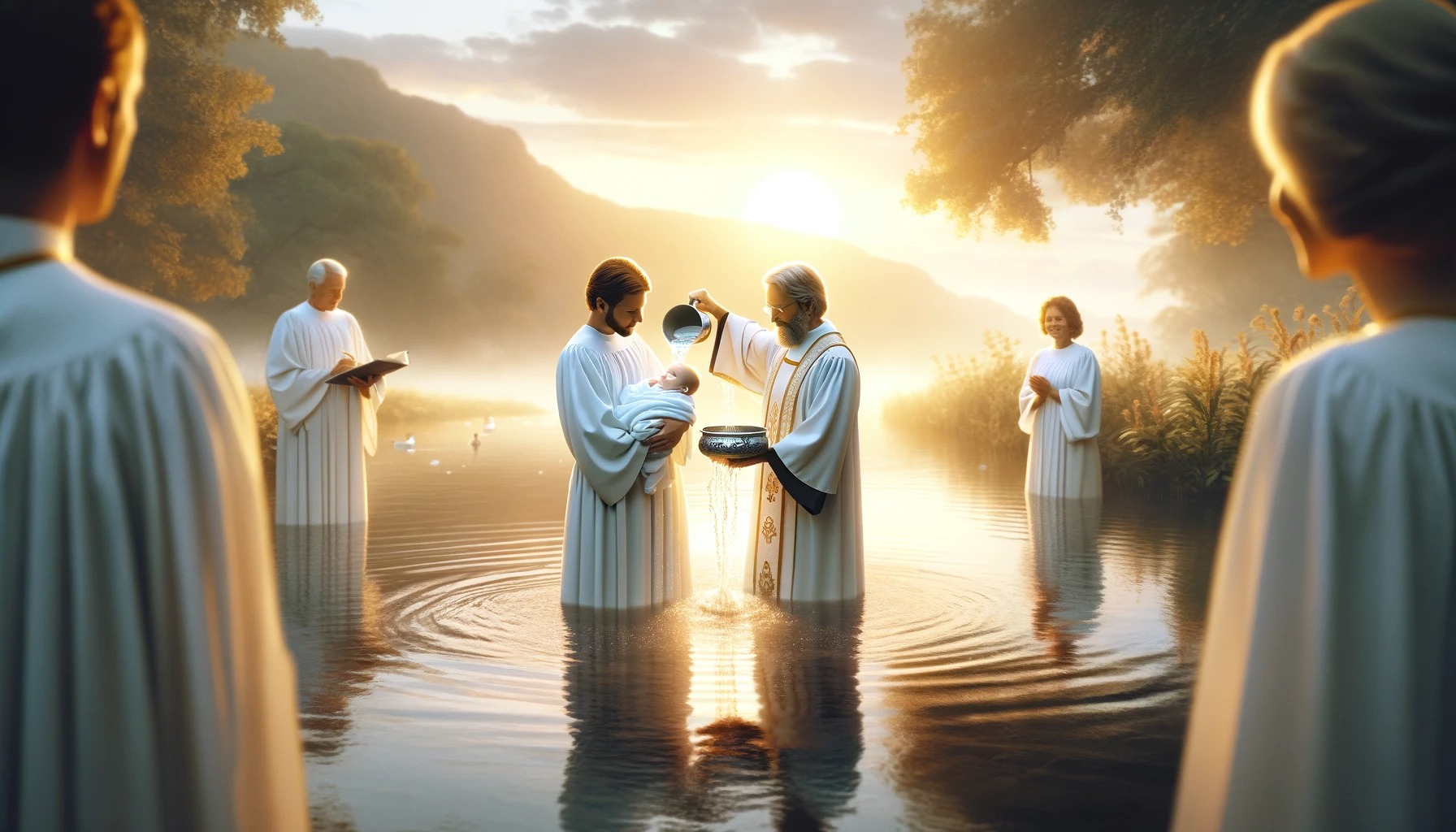Home>Theology and Spirituality>How To Conduct A Baptism?


Theology and Spirituality
How To Conduct A Baptism?
Published: February 26, 2024
Peter Smith, Editorial Director at Christian.net, combines deep insights into faith, politics, and culture to lead content creation that resonates widely. Awarded for his contributions to religious discourse, he previously headed a major organization for religious communicators, enhancing dialogue on faith's societal impacts.
Learn the steps and significance of conducting a baptism in theology and spirituality. Discover the essential practices and symbolism involved.
(Many of the links in this article redirect to a specific reviewed product. Your purchase of these products through affiliate links helps to generate commission for Christian.net, at no extra cost. Learn more)
Table of Contents
Understanding the Significance of Baptism
Baptism holds a significant place in many religious traditions, symbolizing the cleansing of sins and the initiation into the faith community. It is a sacred rite that marks the beginning of a spiritual journey and a commitment to living according to the principles of the particular faith. The act of baptism is often seen as a public declaration of one's faith and a symbol of rebirth or renewal. In Christianity, for example, baptism is viewed as a sacrament that washes away original sin and incorporates the individual into the body of Christ. The significance of baptism extends beyond the physical act of immersion in water; it represents a spiritual transformation and a deepening of one's connection to the divine.
-
Symbol of Cleansing and Renewal: Baptism is often likened to a spiritual cleansing, where the individual is symbolically washed of their sins and impurities. This act of purification signifies a fresh start and a commitment to leading a life in accordance with the teachings of the faith.
-
Initiation into the Faith Community: Through baptism, individuals are formally welcomed into the religious community. It serves as a rite of passage, signifying their acceptance and inclusion within the faith tradition.
-
Public Declaration of Faith: Baptism is a public declaration of one's commitment to their religious beliefs. It is a visible and outward expression of an inward faith, often witnessed by family, friends, and fellow members of the faith community.
-
Sacramental Significance: In many religious traditions, baptism is considered a sacrament, a sacred and outward sign of an inward grace. It is believed to impart spiritual blessings and grace upon the individual, marking their entry into the divine covenant.
-
Symbol of Rebirth and Renewal: The act of immersion in water during baptism is often seen as a symbol of rebirth and renewal. It represents a spiritual awakening and a new beginning in the life of the baptized individual.
Understanding the significance of baptism is essential for those preparing to undergo this sacred rite, as it underscores the spiritual and communal dimensions of the ceremony. It serves as a profound symbol of faith, unity, and spiritual transformation within religious communities.
Read more: How To Prepare For Baptism
Preparing for the Baptism Ceremony
-
Consult with Religious Leaders: Before the baptism ceremony, it is essential to consult with religious leaders or clergy members to understand the specific requirements and customs associated with the baptism in your faith tradition. They can provide guidance on the necessary preparations and offer insights into the significance of the ceremony within the context of your religious beliefs.
-
Select Godparents or Sponsors: In many religious traditions, godparents or sponsors play a significant role in the baptism ceremony. They are chosen to provide spiritual guidance and support to the baptized individual. It is important to carefully select godparents who are committed to their faith and willing to take on this responsibility.
-
Attend Pre-Baptismal Classes: Some religious denominations require individuals or parents of infants to attend pre-baptismal classes. These classes offer instruction on the meaning of baptism, its significance within the faith, and the responsibilities associated with raising a child in the religious tradition.
-
Prepare Necessary Documentation: Depending on the religious tradition, there may be specific documentation required for the baptism. This could include birth certificates, letters of permission, or other formalities. It is important to gather and prepare these documents well in advance of the ceremony.
-
Select Readings and Prayers: If the baptism ceremony includes readings or prayers, take the time to select meaningful passages that reflect the significance of the occasion. These readings can add depth and spiritual resonance to the ceremony, creating a memorable and meaningful experience for all involved.
-
Arrange for the Sacramental Elements: In some traditions, there are specific sacramental elements used during the baptism ceremony, such as holy water, oils, or candles. Ensure that these elements are prepared and available for the ceremony, following any prescribed rituals or blessings associated with them.
-
Coordinate with the Church or Venue: If the baptism is to take place in a church or other religious venue, coordinate with the appropriate authorities to ensure that the space is prepared for the ceremony. This may include arranging for seating, decorations, and any other logistical considerations.
-
Prepare Personal Reflections: For those being baptized, or for parents presenting their children for baptism, taking time for personal reflection on the significance of the ceremony can enhance the experience. Consider writing personal reflections or statements to share during the ceremony, expressing the spiritual significance of the occasion.
By diligently preparing for the baptism ceremony, individuals and families can ensure that the event is conducted with reverence and in accordance with the customs and traditions of their faith. This preparation contributes to the meaningful and spiritually enriching nature of the baptism experience.
Choosing the Right Location for the Baptism
-
Consider the Religious Tradition: The choice of location for a baptism is often influenced by the religious tradition to which the individual or family belongs. For some, a baptismal font within a church holds deep significance, while others may opt for natural bodies of water, such as rivers or lakes, in accordance with their faith's customs. Understanding the religious significance of different locations is crucial in making an informed decision.
-
Accessibility and Accommodation: When selecting a location for the baptism, it is important to consider the accessibility and accommodation of the venue. If the baptism is to be a public ceremony with a large number of attendees, choosing a location that can comfortably accommodate the guests is essential. Additionally, ensuring that the venue is accessible to all participants, including those with mobility challenges, is a key consideration.
-
Symbolic and Spiritual Significance: The chosen location should hold symbolic and spiritual significance within the context of the religious tradition. For example, a natural body of water may symbolize purification and renewal, while a church setting may represent the sanctity and sacredness of the baptismal rite. Understanding the symbolic implications of the location adds depth and meaning to the ceremony.
-
Consultation with Religious Authorities: It is advisable to consult with religious authorities or clergy members when deciding on the location for the baptism. They can provide guidance on the appropriateness of different venues based on the religious teachings and customs. Their insights can help ensure that the chosen location aligns with the spiritual and ceremonial requirements of the baptism.
-
Personal Significance: Consider the personal significance of potential locations. For some individuals or families, choosing a location that holds personal meaning, such as a family church or a place of natural beauty, can enhance the emotional and spiritual resonance of the baptism. Reflecting on the personal significance of different venues can aid in making a heartfelt and meaningful choice.
-
Logistical Considerations: Practical considerations, such as the availability of facilities, parking, and any necessary permits or permissions, should also factor into the decision. Ensuring that the chosen location can accommodate the practical needs of the ceremony contributes to the smooth execution of the baptism.
Choosing the right location for the baptism involves a thoughtful consideration of religious, symbolic, practical, and personal factors. By carefully evaluating these aspects, individuals and families can select a location that honors the spiritual significance of the baptism and creates a memorable and meaningful experience for all involved.
Selecting a Baptismal Gown or Outfit
Selecting the appropriate baptismal gown or outfit is a significant aspect of preparing for the baptism ceremony. The attire chosen for this sacred occasion often holds symbolic and traditional significance, reflecting the solemnity and spiritual importance of the rite. Whether it is a flowing gown, a traditional robe, or a special outfit, the selection process involves careful consideration of religious customs, personal preferences, and the desire to honor the spiritual significance of the baptism.
Traditional and Symbolic Considerations
In many religious traditions, the baptismal gown or outfit carries deep symbolic meaning. It is often white, symbolizing purity, innocence, and the washing away of sin. The color white is emblematic of the spiritual cleansing and renewal that is central to the baptismal ceremony. Additionally, the flowing nature of baptismal gowns symbolizes the spiritual rebirth and the emergence of the baptized individual into a new life within the faith community. Understanding the traditional and symbolic significance of the attire is essential in selecting a gown or outfit that aligns with the spiritual and ceremonial aspects of the baptism.
Read more: How To Do A Baptism
Cultural and Family Traditions
In some cases, families may have cultural or familial traditions associated with baptismal attire. Certain ethnic or cultural groups have specific customs related to the style, design, or embellishments of baptismal gowns or outfits. These traditions may be passed down through generations, carrying with them a sense of heritage and familial connection. When selecting a baptismal gown or outfit, individuals and families may choose to honor these cultural traditions, adding a layer of personal and familial significance to the attire.
Practical Considerations
While the symbolic and traditional aspects of baptismal attire are paramount, practical considerations also play a role in the selection process. The comfort and ease of movement for the individual being baptized, particularly in the case of infants or young children, are important factors to consider. Additionally, the appropriateness of the attire for the chosen location and the season in which the baptism takes place should be taken into account. Ensuring that the selected gown or outfit is both practical and in line with the ceremonial requirements contributes to a seamless and meaningful baptism experience.
Personalization and Meaningful Touches
Many families choose to personalize the baptismal gown or outfit to add a unique and meaningful touch to the ceremony. This may involve incorporating heirloom pieces, such as a family veil or a special accessory, into the attire. Personalization can also extend to the selection of fabrics, embellishments, or embroidery that hold personal significance. By infusing the attire with personal touches, individuals and families can create a deeply meaningful and memorable aspect of the baptism ceremony.
Involving Family and Community
The process of selecting a baptismal gown or outfit can be an opportunity to involve family members and the broader faith community. Seeking input or guidance from family elders, godparents, or members of the religious community can enrich the selection process, fostering a sense of communal support and involvement in the baptismal preparations. Additionally, involving loved ones in the process can deepen the familial and communal bonds that are celebrated during the baptism ceremony.
Read more: How To Celebrate A Baptism
Reflecting the Sacredness of the Occasion
Ultimately, the selection of a baptismal gown or outfit is a reflection of the sacredness and significance of the baptism ceremony. It is a visual representation of the spiritual rebirth and commitment to the faith that the baptism signifies. By carefully considering the traditional, cultural, personal, and practical aspects of the attire, individuals and families can ensure that the chosen gown or outfit honors the spiritual depth of the occasion and contributes to a reverent and memorable baptism experience.
Inviting Family and Friends to Attend the Baptism
Inviting family and friends to attend the baptism is a significant aspect of the preparation process, as their presence adds to the communal celebration of this sacred rite. The participation of loved ones not only provides support and encouragement to the individual being baptized but also fosters a sense of community and shared spiritual joy. Here are several key considerations when extending invitations to family and friends for the baptism ceremony:
-
Early Notification: It is important to provide early notification to family and friends regarding the date, time, and location of the baptism. This allows them to make necessary arrangements to attend the ceremony, particularly if they need to travel from a distance. Early notification also demonstrates the significance of their presence at this important event.
-
Personalized Invitations: Consider sending personalized invitations to family and friends, especially those who hold a special place in the life of the individual being baptized. Personalized invitations can convey the heartfelt significance of their attendance and create a sense of anticipation and honor surrounding the ceremony.
-
Inclusion of Godparents and Sponsors: If the baptism involves the role of godparents or sponsors, it is essential to extend formal invitations to these individuals. The participation of godparents is a central aspect of the baptism ceremony, and their presence holds deep spiritual and symbolic significance.
-
Communication of Expectations: When inviting family and friends to attend the baptism, it is helpful to communicate any specific expectations or customs associated with the ceremony. This may include dress code, participation in readings or prayers, or any cultural or religious observances that guests should be aware of.
-
Involvement in Pre-Baptismal Activities: Encourage family and friends to be involved in pre-baptismal activities, such as pre-ceremony gatherings, prayer services, or other communal preparations. Involving loved ones in these activities creates a sense of shared spiritual preparation and unity leading up to the baptism.
-
Acknowledgment of Support: Express gratitude for the support and presence of family and friends in the baptism invitation. Acknowledge the role that their love, guidance, and encouragement have played in the spiritual journey of the individual being baptized, and convey the significance of their continued support in the future.
-
Inclusion of Extended Community: In addition to immediate family and close friends, consider extending invitations to members of the broader faith community. The participation of fellow congregants, religious leaders, and community members can enrich the communal nature of the baptism and create a sense of shared spiritual celebration.
-
Post-Ceremony Gathering: Following the baptism ceremony, consider organizing a post-ceremony gathering or reception to further celebrate and express gratitude to family and friends for their attendance. This provides an opportunity for communal fellowship and reflection on the significance of the baptism.
By thoughtfully inviting family and friends to attend the baptism, individuals and families can create a communal atmosphere of love, support, and spiritual celebration, enriching the overall experience of this sacred rite.
Conducting the Baptism Ceremony
The actual conduct of the baptism ceremony is a pivotal moment, representing the culmination of spiritual preparation and the initiation into the faith community. The ceremony itself is imbued with symbolic actions, prayers, and rituals that hold deep significance within the religious tradition. Here are the key elements involved in conducting the baptism ceremony:
Preparation of the Baptismal Space
Before the ceremony begins, the baptismal space is prepared in accordance with the religious customs and traditions. This may involve the blessing of the water, the lighting of candles, and the arrangement of the baptismal font or immersion pool. The space is adorned to reflect the sanctity and spiritual significance of the baptismal rite.
Read more: How To Invite For Baptism
Welcoming the Congregation
As the congregation gathers for the ceremony, there is a sense of anticipation and reverence. The presiding clergy or religious leader may offer words of welcome, setting the tone for the sacred nature of the occasion. The congregation's presence serves as a symbol of communal support and shared spiritual commitment.
Invocation of Blessings
The baptism ceremony often begins with an invocation of blessings, calling upon the divine presence to sanctify the waters and bless the individual being baptized. This invocation may include prayers, hymns, or sacred recitations that emphasize the spiritual significance of the baptism.
Renunciation of Sin and Affirmation of Faith
Central to the baptismal rite is the renunciation of sin and the affirmation of faith. The individual being baptized, or their parents and godparents in the case of infant baptism, publicly renounce sin and express their commitment to the beliefs and principles of the faith. This declaration marks the conscious choice to embrace the spiritual path of the religious tradition.
Immersion or Affusion
The method of baptism, whether by immersion in water or affusion (pouring or sprinkling of water), is carried out in accordance with the religious tradition's customs. The act of immersion symbolizes the cleansing of sin and the spiritual rebirth, while affusion represents the outpouring of divine grace and purification.
Read more: How Was The Baptism Of Jesus
Anointing and Blessing
Following the immersion or affusion, the individual being baptized may be anointed with sacred oils or receive a special blessing. These acts symbolize the bestowal of spiritual grace and the anointing of the individual as a member of the faith community. The anointing and blessing are accompanied by prayers and invocations of divine favor.
Welcome into the Faith Community
The culmination of the baptism ceremony involves the formal welcome of the newly baptized individual into the faith community. This may include the presentation of a baptismal certificate, the lighting of a baptismal candle, or other symbolic gestures that signify the individual's incorporation into the religious community.
Communal Celebration and Fellowship
Following the baptism, there is often a sense of communal celebration and fellowship. Family, friends, and members of the congregation come together to offer their congratulations and support to the newly baptized individual. This communal gathering reinforces the sense of shared spiritual joy and unity within the faith community.
Commemoration and Reflection
The baptism ceremony concludes with a spirit of commemoration and reflection. The significance of the occasion is acknowledged, and the newly baptized individual, along with their family and the congregation, may engage in communal prayers, hymns, or reflections that emphasize the spiritual transformation and renewal symbolized by the baptism.
By conducting the baptism ceremony with reverence, adherence to religious customs, and a sense of communal participation, the spiritual significance of the rite is honored, and the newly baptized individual is welcomed into the faith community with love, support, and shared spiritual celebration.
Read more: How Did Baptism Begin?
Following Up After the Baptism
After the baptism ceremony, it is important to engage in thoughtful and meaningful follow-up activities to continue nurturing the spiritual journey of the newly baptized individual and to express gratitude to those who participated in the ceremony. The following are key considerations for the post-baptism follow-up:
Expressing Gratitude
Expressing gratitude to the clergy, godparents, family, and friends who attended the baptism is essential. Sending personalized thank-you notes or messages that convey appreciation for their presence, support, and spiritual guidance reinforces the communal bonds and shared spiritual commitment that were celebrated during the baptism.
Continued Spiritual Guidance
Following the baptism, it is important to continue providing spiritual guidance and support to the newly baptized individual. This may involve regular participation in religious services, engagement with faith-based educational programs, and ongoing conversations about the significance of the baptism and the principles of the faith. Providing opportunities for continued spiritual growth and exploration reinforces the lifelong commitment to the religious tradition.
Commemorative Keepsakes
Creating commemorative keepsakes, such as a baptismal certificate, a personalized Bible, or a memento from the baptism ceremony, serves as a tangible reminder of the spiritual significance of the occasion. These keepsakes can be cherished as symbols of the individual's initiation into the faith community and serve as touchstones for their ongoing spiritual journey.
Read more: How Important Is Baptism For Salvation
Post-Baptismal Celebration
Organizing a post-baptismal celebration or gathering provides an opportunity for family, friends, and members of the faith community to come together in fellowship and celebration. This communal gathering allows for continued expressions of support, encouragement, and shared spiritual joy, further reinforcing the sense of unity within the faith community.
Ongoing Community Involvement
Encouraging ongoing involvement in the faith community through participation in religious services, community outreach initiatives, and communal gatherings fosters a sense of belonging and active engagement. Involvement in the broader faith community provides opportunities for the newly baptized individual to deepen their spiritual connections and contribute to the communal life of the religious tradition.
Reflection and Integration
Encouraging reflection on the significance of the baptism and its integration into daily life is crucial. Engaging in conversations about the spiritual transformation symbolized by the baptism and its relevance to personal values, actions, and relationships reinforces the ongoing impact of the ceremony on the individual's spiritual journey.
Support and Encouragement
Continued support and encouragement from family, godparents, and the broader faith community are vital in nurturing the spiritual growth of the newly baptized individual. Providing avenues for open communication, guidance, and mentorship creates a supportive environment for the individual to navigate their spiritual path within the faith community.
By engaging in thoughtful and intentional follow-up activities after the baptism, individuals and families can sustain the spiritual significance of the ceremony and foster a sense of ongoing communal support, spiritual growth, and shared celebration within the faith community.









